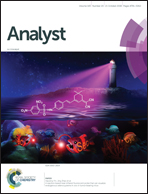Prompting peroxidase-like activity of gold nanorod composites by localized surface plasmon resonance for fast colorimetric detection of prostate specific antigen†
Abstract
The interaction between incident light and surface electrons in conductive nanoparticles produces localized plasmon oscillations with a resonant frequency that strongly depends on the composition, size, geometry, and dielectric environment. Hybrid heterostructure materials combining two or more materials in one structure represent a powerful way to achieve unique properties and multifunctionality compared to those of the individual nanoparticle components. Hybrid gold nanorods and gold nanoclusters (GNR/AuNCs) heterostructures prepared by intimate integration of GNRs with AuNCs exhibit both localized surface plasmon resonance (LSPR) property and peroxidase-like activity. It is found that the catalytic activity of the AuNC/GNR heterostructure could be remarkably enhanced by LSPR induced by photon–plasmon coupling in the visible to near-infrared (NIR) region. Meanwhile, the catalytic activity of enzyme-like AuNC/GNRs may be regulated by immunoreactions to realize specific recognition of a target analyte. Accordingly, a fast colorimetric assay within 5 min for the detection of prostate specific antigen (PSA) was developed based on a AuNC/GNRs heterostructure mask regulated by the target molecule under photon-plasmon coupling. The color intensity is inversely proportional to the PSA concentration, and quantitative analysis may be achieved in a range of 10 and 200 pg mL−1. This sensor was practically applied to detect PSA levels in prostate cancer serum samples and the determined values agreed well with those measured by the hospital using standard methods. This indicates that the AuNC/GNRs heterostructure-based assay has high accuracy for the analysis of practical samples. Moreover, the new method has the advantages of very fast determination and low sample volume requirements.



 Please wait while we load your content...
Please wait while we load your content...